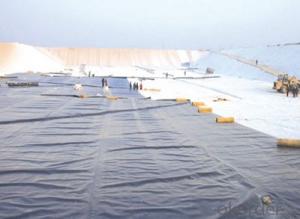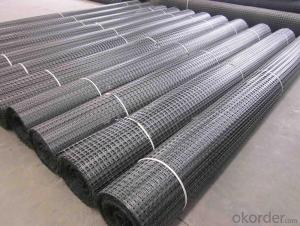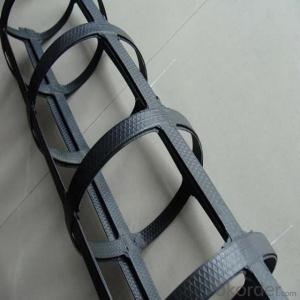Triax Geogrids Reinforced HDPE Textured Geomembrane for River Tunnel Canal
- Loading Port:
- Tianjin
- Payment Terms:
- TT OR LC
- Min Order Qty:
- 88 m²
- Supply Capability:
- 1800000 m²/month
OKorder Service Pledge
OKorder Financial Service
You Might Also Like
The structure of HDPE Textured Geomembrane for River tunnel canel description :
One side or two sides uniformly textu red surface by special blow technology.
Specification of HDPE Textured Geomembrane for River tunnel canel:
I. Thickness: 1.0mm t0 3. 0mm
2.4m-9m in width, roll length as design or client ' s request
Feature of Property of HDPE Textured Geomembrane for River tunnel canel:
I. High flexibility, high waterproof coefficient
2. Could be used in the temperature of -700C - IIOoC
3. Good stability, anti acid and alkalis, anti-erosion
4. High climate bearing ability, excellent in anti-aging
5. High tensile strength and elongation, can be used in bad geology and climate, especially be
Used in the soil uneven sedimentation
6. High friction coefficient
Application of HDPE Textured Geomembrane for River tunnel canel:
I. M unicipal p rojects
2. Landfill treatment projects
3. Waste water treatment
4. Mineral waterproofing
Production standard of HDPE Textured Geomembrane for River tunnel canel:
I. GB/T17643-2011 ( GH-2T1 and GH-2T2 )
2. CJ/T234-2006
3. GRI-GMB
Area |
|
Hydraulic | Lagooning and Water Treatment, Ornamental Ponds, Golf Courses Aquaculture and Desalination Water LagoonsTanks, Reservoirs, Liquid WasteFloating Cover SolutionsDrainage and FiltrationShading Cover Solutions |
Environment | Tailing ponds, Leach mining,Landfills,Landfill Capping,Protection against corrosion,Vertical Barriers |
Civil Works | Erosion Control, Secondary Containment, Tunnels,Linear and Surface Works,Consolidation of Margins,Soil Reinforcement,Soil Separation. |
Building | Parkings,Roofing,Soundproofing building |

Introduction of CNBM
China National Building Materials (Group) Corporation (CNBM) is a state-owned enterprise in charge of administrative affairs in China building materials industry. Established in 1984, CNBM is a large group corporation of building materials with total assets of RMB 25 billion and a total staff of 30,000. Now CNBM owns more than 200 subsidiaries in and abroad the country, including wholly-owned corporations and joint ventures.
FAQ of geosynthetics :
What is geosynthetics ?
Geosynthetics form a perfect erosion control fabric used extremely widely in civil engineering to stabilize and reinforce slopes and soil under or next to roads, railways, dams, water reservoirs etc.. They can be easily applied which minimizes the time of construction, as well as they limit the resources and materials necessary.
What kinds of geosynthetics we have ?
Non-woven geotextile, geogrids, geocells, GCL, Geomembranes, Geonets, Geocomposites etc .
What is the geosynthetics used for ?
Hydraulic
Lagooning and Water Treatment, Ornamental Ponds, Golf Courses
Aquaculture and Desalination,Water Lagoons,Tanks, Reservoirs, Liquid Waste,Floating Cover Solutions, Drainage and Filtration
Environment
Tailing ponds, Leach mining,Landfills,Landfill Capping,Protection against corrosion,Vertical Barriers
Civil Works
Erosion Control,Secondary Containment,Tunnels,Linear and Surface Works,Consolidation of Margins,Soil Reinforcement,Soil Separation.
Building - Parkings,Roofing,Soundproofing
- Q: Are geogrids suitable for reinforcing bridge abutment backfills?
- Yes, geogrids are suitable for reinforcing bridge abutment backfills. Geogrids are commonly used in civil engineering projects to enhance soil stability and provide reinforcement. They can effectively distribute the load and prevent soil movement, thereby improving the overall strength and performance of bridge abutment backfills.
- Q: Can geogrids be used in slope stabilization for railway embankments with high water table conditions?
- Yes, geogrids can be used in slope stabilization for railway embankments with high water table conditions. Geogrids offer effective reinforcement and soil confinement, preventing soil erosion and enhancing the stability of the embankment even in areas with high water levels. They provide additional strength and support to the soil, reducing the risk of slope failure and improving the overall stability of the railway embankment.
- Q: Are geogrids suitable for use in ground reinforcement for wind farms?
- Yes, geogrids are suitable for use in ground reinforcement for wind farms. Geogrids provide excellent load-bearing capacity, soil stabilization, and erosion control, making them ideal for reinforcing the ground in areas with high wind speeds. They distribute loads effectively, reduce soil movement, and enhance the overall stability of the ground, ensuring the proper functioning and longevity of wind farm infrastructure.
- Q: How do geogrids improve the performance of soil retaining structures?
- Geogrids improve the performance of soil retaining structures by providing reinforcement and stability to the soil. They distribute the applied loads more evenly, reduce soil movement and prevent the occurrence of sliding or failure. Additionally, geogrids increase the bearing capacity of the soil, enhance drainage, and improve overall durability and longevity of the retaining structures.
- Q: Glass fiber mesh cloth.
- 3) granite, mosaic special mesh, marble back web.4 waterproofing membrane, asphalt roofing waterproof.5) reinforced plastic and rubber products.
- Q: Plastic grid plate making process
- Geogrid is divided into four categories: plastic geogrid, steel plastic geogrid, fiberglass geogrid and fiberglass polyester geogrid. The plastic geogrid is a kind of polymer material with square or rectangular shape which is formed by stretching, and it can be used as two kinds of uniaxial tension and biaxial tension. The utility model is punched on the extruded polymer plate (raw material is polypropylene or high-density polyethylene), and then directionally stretched under the heating condition. The unidirectional stretching grid is only drawn along the length direction of the plate, and the bidirectional stretching grid is made by stretching the unidirectional stretching grid in the direction perpendicular to the length.
- Q: Do geogrids provide long-term stability to slopes?
- Yes, geogrids provide long-term stability to slopes. Geogrids are commonly used in slope reinforcement systems to increase the strength and stability of slopes. These materials effectively distribute loads, reduce soil erosion, and enhance soil reinforcement over time, thereby ensuring long-term stability for slopes.
- Q: Why steel plastic geogrid in the test, will choose to peel out a single wire test? What are the causes and sources of this method
- Peel out because of the more intuitive understanding of the strength of the tensile strength and extension of the length of the wire wrapped in order to protect the steel wire does not rust.
- Q: Can geogrids be used in reinforced earth bridge abutments in liquefaction-prone areas?
- Yes, geogrids can be used in reinforced earth bridge abutments in liquefaction-prone areas. Geogrids are often used in such areas to provide additional stability and to mitigate the effects of liquefaction. They help distribute loads and reinforce the soil, reducing the risk of settlement or failure during liquefaction events.
- Q: What are the long-term durability characteristics of geogrids?
- Geogrids have excellent long-term durability characteristics due to their high tensile strength and resistance to environmental factors such as UV radiation, chemicals, and biological degradation. They are designed to withstand the stress and strain imposed by various applications, including soil reinforcement, slope stabilization, and pavement construction. Geogrids also maintain their structural integrity over time, providing long-lasting support and stability to infrastructure projects.
Send your message to us
Triax Geogrids Reinforced HDPE Textured Geomembrane for River Tunnel Canal
- Loading Port:
- Tianjin
- Payment Terms:
- TT OR LC
- Min Order Qty:
- 88 m²
- Supply Capability:
- 1800000 m²/month
OKorder Service Pledge
OKorder Financial Service
Similar products
Hot products
Hot Searches
Related keywords






























